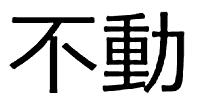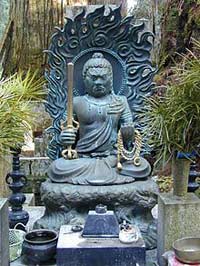Martial Arts: Defining Martial Concepts
Fudo:
The Concept of Immovability
By Christopher Caile

|
Fudo is an English translation of two characters (Japanese kanji), "Fu" translates as "not" (left character) and the second (a compound character of "strength" (right most character) and "heavy" (middle character) combine to mean "move." In other words the characters used for "Fudo" combine to mean "not move" or in better English, immovable, immovability or stability. |
Fudo is a Japanese term often used in Buddhism, especially in Zen and Esoteric Buddhism (Mikkyo) to represent a mental state -- one of immovability, not physically or literally, but in mind, one that is not captured, or moved, or dwells, or loiters on a thought or in a focus - a total unobstructed awareness and focus on everything, thus not moving with, or fixed upon something (limited by a focused attention).
In the martial arts the character "shin," meaning spirit, heart or will, is often added to the root "fudo" to become "fudoshin," a term meaning calm spirit, even when faced with danger, without fear or confusion, that does not dwell or become fixed on anything. This was the highest attainment of spiritual skill only attainable when the mind is totally focused on the totality of sensory input and free of thoughts and emotions - detached but aware and present. A related term "mushin" also is often used to mean "without mind" (not occupied by thought or emotion). (1)
Using the "fudo" root, other related terms include "fudo-chi," meaning immovable spirit or wisdom that can't be influenced, or confused, "fudotai" or immovable body, and "fudoshise" or immovable stance and "fudo-dachi" or "immovable stance" also sometimes referred to as a "preparation stance" (as in the initial and final stance in kata, one that allows the participant freedom of movement and action in any direction).
 Fudo Myo-o, a Japanese deity (also know as Acala), the God of Fire, a manifestation of the central sun (Vairocana), a fierce God of Indian origin although neither a Buddha nor Bodhisattva. A male, he is usually portrayed as livid blue in color with a terrible facial expression standing or sitting on a rock surrounded by flames, gripping a sword in the right hand, a rope in the left, teeth bared and with angry eyes. He is an important ancient Japanese deity (considered a guardian of Buddhism), revered by Buddhists, especially by the Shingon sect of Esoteric Buddhism (Mikkyo), this branch of Buddhism being a religious practice of many Japanese Samurai in feudal times whose fierce face and inner calmness and strength were attributes highly prized. Fudo Myo-o, a Japanese deity (also know as Acala), the God of Fire, a manifestation of the central sun (Vairocana), a fierce God of Indian origin although neither a Buddha nor Bodhisattva. A male, he is usually portrayed as livid blue in color with a terrible facial expression standing or sitting on a rock surrounded by flames, gripping a sword in the right hand, a rope in the left, teeth bared and with angry eyes. He is an important ancient Japanese deity (considered a guardian of Buddhism), revered by Buddhists, especially by the Shingon sect of Esoteric Buddhism (Mikkyo), this branch of Buddhism being a religious practice of many Japanese Samurai in feudal times whose fierce face and inner calmness and strength were attributes highly prized.
|
Many Japanese Samurai practiced Esoteric Buddhism (Mikkyo), (2) especially revering the deity Fudo Myo-o. They saw themselves as guardians of order in a nation besieged with disorder just as Fudo Myo-o served as a guardian of Buddhism. Fudo Myo-o also represented the highest attainment of the Samurai state of mind -- the mind that does not move, and the body that is not unsettled even when surrounded by danger. Because of this reverence, statues and brushed images of this deity were very popular. Images of Fudo Myo-o also often adorned samurai armor and weapons.
The concept of "Fudo" is also important to martial artists. The famous Zen priest Takuan in his famous three part treatise titled "Fudochi Shinmyoroku" ("The Mysterious Records of Immovable Wisdom") identifies Fudo-Myo-o attributes as they apply to Japanese (Samurai) swordsmanship. He notes the Fudo Myo-o's grasp of the sword in his right hand, his body standing firmly with mind immovable (detached and not distracted), looking at something but not stopping the mind during a flow of action or combat. He warned the Samurai against stopping the mind on a particular object, emotion or thought, noting that such stopping clutters (stops) the mind, something that curtailed the performance of technique.
The most famous Japanese swordsman known today is Miyemoto Masashi. He too was influenced by Fudo Myo-o. "Fudo" and its derivative concepts (noted above) represent a central concept in Masashi's strategy of combat (that reflect Takuan's tenets), (3) ideas he later encapsulated in his famous text on strategy, "The Book of Five Rings."
Even today many martial artists use Zazen (seated Zen meditation), chants (some derived from Esoteric Buddhism), and other to clear, fortify and purify the mind. Standing and/or meditating under a cold waterfall is another similar practice. Morihei Ueshiba, the founder of Aikido, is famous for this practice (which he termed Misogi) of ritual purification. (4)
It should be noted, however, that in modern times most martial artists who use these practices do so to enhance their mental and spiritual discipline, and to clarity their awareness and mind, ends that are separate from any religion or religious doctrine.
Modern martial artists also express similar concepts of the immovable mind. Mas Oyama (founder of Kyokushinkai karate and one of my first karate teachers), for example, used to tell me that the ideal karate mind is that of a person who could walk through a burning building without fear -- a very Fudo Myo-o image.
Kaicho Tadashi Nakamura (founder of Seido Karate and my current karate teacher) has said that a true karate-ka must be present in the now, the present moment, totally absorbed in action, mind void of distraction (thought or emotion) and spirit supreme.
Author's Note:
Two other articles on FightingArts.com give practical advice related to the concept of "no mind." See: "Fighting Zen - How Meditation Can Enhance Your Fighting Skills" and is "Controlling The Flinch, The Blink and The Turn Away."
Footnotes:
1-Mushin or "no mind" is also a very popular concept in Zen where meditation is used to free the mind of thought or emotions while simultaneously developing awareness, and focus, not on just one spot or image, but on everything perceived.
2-Few Samurai before the Edo period actually practiced Zen, although later it became popular.
3-Masashi is also noted for his brushwork and drawings, one being a remarkable 18 inch high wood carving he made of Fudo Myo-o. Masashi is also known for his practice of ritually purifying himself under ice cold waterfalls. There is no evidence, however, that Masashi actually practiced esoteric Mikkyo Buddhism in addition to his study of Zen, although he was influenced by Fudo Myo-o.
4-When I visited Ueshiba's summer retreat and dojo in Iwama, Japan in 1994 (later the home dojo of Seito Sensei), students talked about the waterfall in the nearby hills that Ueshiba has often used for this practice. _
About The Author:
Christopher Caile is the Founder and Editor of FightingArts.com, a website dedicated to traditional martial arts. A student of martial arts since 1959, Caile holds a 7th dan in Seido Karate, plus has extensive experience in Kyokushinkai and Shorin ryu karate, kobudo (traditional Okinawan weapons), judo, boxing, Zen and Chinese arts such as White Eyebrow and Praying Mantis. He also holds a teaching rank in aikido and has practiced several forms of daito-ryu aikijujutsu. He lived in Japan and returns regularly to continue research in his field. He has authored hundreds articles on martial arts as well as Chinese medicine (qi gong) in which he is a practitioner and teacher. Caile holds an M.A. in International Relations from American University in Washington D.C. and in addition to his martial arts, he was an inventor, newspaper reporter and photographer as well as founder and president of a private telephone company, a boat building enterprise and an electronics development company. |